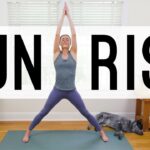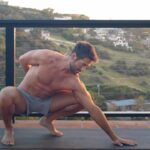Get full access to Outside Learn, our online education hub featuring in-depth yoga, fitness, & nutrition courses, when you
sign up for Outside+.
It’s still dark when the alarm rings at 5:18 am. I roll over and silence it before it wakes my son, who’s tangled in the sheets next to me. He came in after a nightmare a few hours earlier, chasing my husband to the bedroom down the hall, and I never fell back asleep. He kicks and grasps. I listen for his breathing to slow.
In my head, I know it’s time to get out of bed, make coffee, and roll out my mat. But my body is begging for something different. The few hours I slept must have been on my injured shoulder because the pain is already creeping up my neck. I’m stuck between wanting to rest and remain a comfort for my son and getting in my practice before the day formally begins. I feel paralyzed, knowing I’ll struggle with regret no matter my decision.
My yoga practice
For years, I steadied myself with a lengthy, disciplined home practice each morning. I performed Sun Salutations while the stars were still visible and I practiced Chaturanga, Handstand, and intense backbends while everyone else in the house slept. This allowed me to receive the inevitable chaos of the day in a manner that was relatively peaceful and balanced. I depended on my practice for that.
Then, after 15 years of home practice, I tore a labrum in my right shoulder. My doctor advised me to no longer carry my two-year old on my right hip. Sleep was painful without medication.
I told myself that I was the cause of my injury. That my Chaturanga had gotten sloppy. I became hyper-focused on my alignment and increased my attention on core work. Things got worse. I modified my practice but the pain continued to be relentless. I struggled to drive a car and type on a keyboard.
The realization that my yoga practice was introducing suffering into my life forced me to ask whether my perception had become clouded. I had to discern whether or not, after years and years of a demanding physical practice that took time away from my family, I was truly living a life of peace and health.
I eventually responded to my situation by changing the shapes I created on my mat. I stopped critiquing my form in the mirror and instead began listening at a cellular level to what was happening, what I was needing. Chaturanga became optional, arm balances rare. My pace slowed, my breath deepened. I continued to wake early, but to meditate. My practice was no less intense than before, although it was completely different.
Was I quiet quitting yoga?
It was late afternoon on a weekday when a friend calls in tears. Her work had been intense for the last couple of years with unrealistic standards and impossible workloads. “My boss is afraid I’m quietly quitting,” she says. “But I swear I’m doing my job.”
While she talks, I silently search for “What is quiet quitting?” I skim article after article depicting corporate malaise and employee disengagement. What I read about doesn’t describe my friend at all—she’s the hardest worker I know. But she, like so many of us, associates her success as an individual with work well done. To have her work questioned is to have her worth questioned.
As we end our call, I think to myself, is this what I’ve been doing? Have I been quiet quitting my yoga practice?
My evolving relationship to yoga
I was taught that yoga practice is a direct connection to Source. At some point, my brain decided that the more intense my practice, the more intense my connection. When my physical body began to break down, setting critical boundaries, a part of me could not accept the loss of that connection.
Whether it’s part of the beauty of the discipline of yoga or one of the more frustrating aspects of it, ancient texts are hesitant to verbalize a standard of practice. The common refrain among scholars is that within Patanjali’s yoga sutras, only one actual asana is described. In these texts, the practice of yoga is elaborated upon in a manner that instead guides and protects us, often from ourselves.
Three sutras in particular reference the nature of practice. Sutra 1.12 reads, “Mental modifications are restrained by practice and detachment.” This is commonly understood as a willingness to practice without any sense of need or outcome. We don’t practice because it will make us feel better throughout the day. We just practice. We don’t practice to gain followers. We just practice. We don’t practice because our back is aching. We just practice.
Sutra 1.13 continues the conversation. “Of these two [practice and detachment], effort toward steadiness of mind is practice.” My teacher long ago instilled in me some modicum of balance with my practice by including the word “any.” Any effort toward steadiness of mind is practice. When we consciously place ourselves in the world, we are practicing yoga. There is meditation in rocking a child back to sleep. There is alignment found in a lover’s embrace.
The third, Sutra 1.14, provides the larger framework. “Practice becomes firmly grounded when well attended to for a long time, without break and in all earnestness.” Yoga is a lifestyle choice, not an exercise. The practice continues after we roll up the mat or come away from seated meditation. We need to still be yogis after we post the reel and when someone gets our green juice order wrong. The essential word here is “earnestness.” The work that we put in, whether on our mats or at our desks or with our loved ones, is meant to sustain our lives, not define us.
The practice of yoga and meditation is a training ground for all of the other moments in our lives. When we begin to practice presence, we realize that this, too, is yoga as much as any elaborate asana.
Coming back to connection
I check in with my friend after I put the kids down. She stayed at her desk late, fully knowing that her presence was meaningless because her work is dependent upon others who had left for the night. Her phone chimes in the background with texts from her boss.
The relentless pushing is aggression disguised as discipline, and it will hurt her in the end. I can see it in her just as I had seen it in myself. She finds inspiration in lunch hour walks as much as in sales spreadsheets. Conversations with kittens at the animal shelter where she volunteers prepare her for large corporate audiences.
She understands balance and its necessity. And so do I. “Maybe that’s why they call it Warrior Pose,” I say. “There’s a lot of standing up for ourselves.”
When my alarm goes off the next morning, my son is there. Again, I’m exhausted upon waking. But today I’m not afraid of being unaligned with my agenda. Of simply being. I head downstairs and make coffee, then trek across the dark lawn to my practice space. I settle myself on a cushion and begin to listen. My presence has disturbed a cricket living in a corner of the shed, and when it chirps, it feels as if the universe itself is speaking to me.
Within every moment exists the opportunity to practice, and in that knowledge rests the true connection.
About our contributor
MacDuff Perkins is the co-owner and co-founder of Blue Lotus Yoga Studio in Annapolis, MD.
This content was originally published here.




















